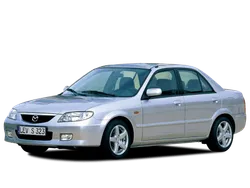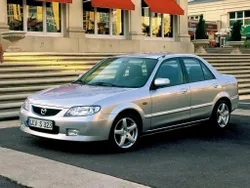

Mazda 323 Generation 6 BJ Facelift 2000 Review
Explore the Mazda 323, particularly the 2000 Generation 6 BJ Facelift, renowned in Portugal for its reliability and performance. Learn more about this iconic model's features.
The Mazda 323, a compact car produced by the Japanese manufacturer Mazda, has been a popular choice for drivers seeking reliability and efficiency since its inception in 1963. The sixth generation, kn...
Technical Specifications
Select Version
Dimensions
Engine
Driving
Others
History and Features
Mycarro AI
Apr 27, 2025
The Mazda 323, a compact car produced by the Japanese manufacturer Mazda, has been a popular choice for drivers seeking reliability and efficiency since its inception in 1963. The sixth generation, known as the BJ series, was introduced in 1998 and represented a significant evolution in design, performance, and technology. This article focuses on the 2000 facelift of the Mazda 323, exploring its enhancements and the reasons behind its enduring appeal.
Styling and Design Enhancements
The 2000 facelift of the Mazda 323 (BJ) introduced subtle yet impactful design changes that modernized its exterior. While the overall silhouette remained consistent with its predecessor, the new model featured a redesigned front grille and updated headlights that provided a sharper, more aggressive look. The addition of newer, sleek lines and curves gave the car a more aerodynamic profile, contributing not only to aesthetics but also to improved fuel efficiency.
Furthermore, the facelift included new wheel designs and optional alloy wheels, enhancing the car's sporty demeanor. The rear lights were also restyled to match the updated front-end look, giving the vehicle a more cohesive and contemporary design that was well-received by consumers.
Interior Comfort and Features
Inside the Mazda 323, the facelift brought about significant improvements. The cabin was designed with attention to detail, providing a comfortable environment for both drivers and passengers. Higher-quality materials were used throughout, and modifications were made to the layout to create a more user-friendly experience.
The dashboard received upgrades, with improved ergonomics and better placement of controls. The facelifted model offered a range of features including new audio systems, air conditioning, and power windows, ensuring that the vehicle was competitive with more modern alternatives. Additionally, the rear seat space was generous for a compact car, allowing for practical use in everyday driving situations.
Engine and Performance
One of the key aspects of the Mazda 323's facelift was the changes made to its engine lineup. Mazda focused on efficiency and performance, offering a variety of engine options, including a 1.6-liter and a 2.0-liter four-cylinder engine. These engines were designed to provide a good balance of power and fuel economy, aligning with the growing demand for environmentally friendly vehicles during that era.
Improvements in fuel efficiency were notable, thanks in part to the introduction of advanced engine technologies that enhanced combustion processes. The vehicle also featured improved suspension tuning, which contributed to a more comfortable ride and better handling characteristics, giving drivers the confidence they needed on both city streets and open highways.
Safety Features
In an effort to keep up with evolving safety standards, the facelifted Mazda 323 included a range of safety features. Newer models came equipped with dual front airbags, ABS (anti-lock braking system), and improved crumple zones in the body structure. The emphasis on safety gave consumers peace of mind, especially for families who relied on this vehicle as their primary mode of transport.
The Mazda 323’s facelift was well-timed, coinciding with a growing consumer awareness of vehicle safety. This alignment with market trends further cemented the model's reputation as not just an economical choice, but a safe one as well.
Market Reception and Legacy
Upon its release, the facelifted Mazda 323 was well received by both critics and consumers. It offered a compelling combination of affordability, reliability, and modern styling, making it an attractive choice in the compact car segment. The vehicle performed well in sales, contributing to Mazda's reputation as a manufacturer of quality vehicles.
As a result of its successful run, the Mazda 323 (BJ) became an enduring model in the used car market. Enthusiasts and budget-conscious buyers continue to appreciate the vehicle for its blend of style and functionality, ensuring that the legacy of the 2000 facelift lives on in the memories of those who drive it.
Conclusion
In summary, the Mazda 323 Generation 6 (BJ) facelift of 2000 marked a milestone in the evolution of the model. With its stylish updates, improved interior comfort, enhanced performance, and solid safety features, it effectively bridged the gap between classic Mazda durability and modern design. As part of the long-standing lineage of the Mazda 323, this model serves as a testament to the manufacturer's commitment to innovation and consumer satisfaction.
